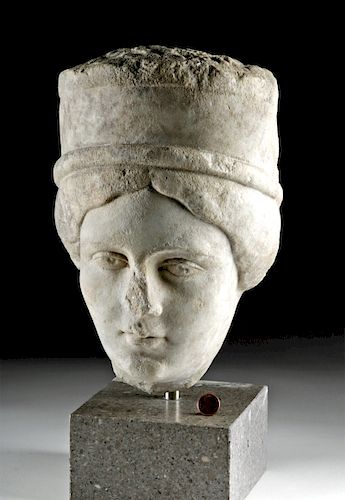Published Roman Marble Head of a Woman, ex-Christie's
Lot 65d
About Seller
Artemis Fine Arts
686 S Taylor Ave, Ste 106
Louisville, CO 80027
United States
Selling antiquities, ancient and ethnographic art online since 1993, Artemis Gallery specializes in Classical Antiquities (Egyptian, Greek, Roman, Near Eastern), Asian, Pre-Columbian, African / Tribal / Oceanographic art. Our extensive inventory includes pottery, stone, metal, wood, glass and textil...Read more
Estimate:
$18,000 - $25,000
Absentee vs Live bid
Two ways to bid:
- Leave a max absentee bid and the platform will bid on your behalf up to your maximum bid during the live auction.
- Bid live during the auction and your bids will be submitted real-time to the auctioneer.
Bid Increments
| Price | Bid Increment |
|---|---|
| $0 | $25 |
| $300 | $50 |
| $1,000 | $100 |
| $2,000 | $250 |
| $5,000 | $500 |
| $10,000 | $1,000 |
| $20,000 | $2,500 |
| $50,000 | $5,000 |
| $100,000 | $10,000 |
| $200,000 | $20,000 |
About Auction
By Artemis Fine Arts
Feb 21, 2019
Set Reminder
2019-02-21 10:00:00
2019-02-21 10:00:00
America/New_York
Bidsquare
Bidsquare : Exceptional Antiquities, Asian, Ethnographic
https://www.bidsquare.com/auctions/artemis-gallery/exceptional-antiquities-asian-ethnographic-3858
An important one-day auction featuring museum-worthy examples of Egyptian, Greek, Roman, Etruscan, Near Eastern, Far East / Asian, Pre-Columbian, African / Tribal, Oceanic, Native American, Spanish Colonial, Russian, Fossils, Ancient Jewelry, Fine Art, so much more! Artemis Fine Arts info@artemisgallery.com
An important one-day auction featuring museum-worthy examples of Egyptian, Greek, Roman, Etruscan, Near Eastern, Far East / Asian, Pre-Columbian, African / Tribal, Oceanic, Native American, Spanish Colonial, Russian, Fossils, Ancient Jewelry, Fine Art, so much more! Artemis Fine Arts info@artemisgallery.com
- Lot Description
Roman, Imperial Period, ca. 2nd to 3rd century CE. A sensitive and lifelike marble portrait of a woman, with lidded and drilled eyes that once would have had inlays. Her eyebrows are thin and delicately carved so that her eyes appear deepset. She has a small mouth with a full lower lip and a small, deeply dimpled chin. Her face is youthful, with smooth features framed by her hair. She wears her gently waved hair parted in the center and pulled back to cover her ears, a coiffure reminiscent of a style popular during the Severan age. On her head, she wears a broad polos, perhaps identifying her as a city goddess. The marble color is slightly mottled with creamy white and sparkling grey. Size: 5.55" L x 7.4" W x 11.25" H (14.1 cm x 18.8 cm x 28.6 cm); 15.25" H (38.7 cm) on included custom stand.
The hairstyle worn by this portrait was inspired by Julia Domna, wife of the emperor Septimius Severus (r. 193 to 211 CE), mother of the emperor Caracalla (r. 211 to 217 CE). She was the daughter of a high-ranking priest from Syria and some believe that her hairstyle was inspired by her foreign origins - indeed, women from Palmyra were known to wear their hair in a center parting with diadems or turbans. The polos worn on this woman's head, however, is Greco-Roman in style and indicates her divinity.
Marble statuary, reliefs, and cladding were ubiquitous in the Roman world, as the remains of the preserved cities at Herculaneum and Pompeii demonstrate. Their sculpture was intended to conjure human vitality, and was inspired by the works of Polykleitos, who became the model to which sculptors aspired in Greco-Roman as well as later Western European art. Greco-Roman statuary, unlike that of the other Mediterranean civilizations like Egypt, Persia, etc., celebrated the naturalistic human form. This included representations of their gods, like this one, who appear as if living people, dressed like ordinary (elite) citizens. This suggests an intriguing, more personal relationship with the gods rather than the more abstract or magical portrayals of other contemporary societies. This head may have featured as the centerpiece of an altar inside a temple, where cult statues of deities served as focal points for worship. It may also have been part of a public display like the Severan-period Septizodium, the monumental fountain built to honor the imperial family and which had a three-story columnar façade decorated with portraits of various gods and goddesses.
Published in "Our Collective Past: A Selection of Objects from Antiquity." Fortuna Fine Arts, Ltd., New York, 2006, fig. 25; featured in Christie's New York auction of April 25, 2017 as Lot 268.
Provenance: private East Coast, USA collection; ex-Gorny and Mosch, Munich, Germany, sale #145, 12/14/200
All items legal to buy/sell under U.S. Statute covering cultural patrimony Code 2600, CHAPTER 14, and are guaranteed to be as described or your money back.
A Certificate of Authenticity will accompany all winning bids.
We ship worldwide and handle all shipping in-house for your convenience.
#143801Loss to nose, and back and top of head, as well as smaller scratches, chips, and nicks commensurate with age, notably on the irises of the eyes. Light deposits on surface. Details of face aside from the nose are well preserved.Condition
- Shipping Info
-
All shipping is handled in-house for your convenience. Your invoice from Artemis Gallery will include shipping calculation instructions. If in doubt, please inquire BEFORE bidding for estimated shipping costs for individual items.
-
- Buyer's Premium



 EUR
EUR CAD
CAD AUD
AUD GBP
GBP MXN
MXN HKD
HKD CNY
CNY MYR
MYR SEK
SEK SGD
SGD CHF
CHF THB
THB














